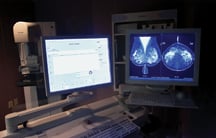
Hologic, Inc. published a large scale breast screening trial comparing a single radiologist using computer-aided detection (CAD) to double reading without CAD.
The author of the study is Dr. Matthew Gromet of the Breast Imaging Section of Charlotte Radiology, a large imaging practice (approximately 66,000 screening mammograms a year) in Charlotte, North Carolina. The study , published in the on-line version of the American Journal of Roentgenology, the scientific journal of the American Roentgen Ray Society, appeared in the April 2008 issue of the research journal. The study compared the recall rate, sensitivity, positive predictive value, and cancer detection rate for single reading with CAD, versus double reading without CAD. Biopsy and pathology data for positive cases were also compared.
Dr. Gromet found that a single reader with CAD had a statistically significant increase in sensitivity (11 percent) and a smaller increase in recall rate (4 percent), when compared a single reader without CAD assistance. He also found that single reading with CAD review, when compared with independent double reading, resulted in a not statistically significant increase in sensitivity but with a statistically significant lower recall rate. With manpower constraints limiting the use of double reading, Dr. Gromet concludes that “CAD appears to be an effective alternative that provides similar, and potentially greater, benefits.”
The results were based on the performance of nine radiologists at Charlotte Radiology with a mean level of experience in mammography of 15 years. The mammograms in the study were screen-film studies obtained on Hologic mammography equipment. The CAD technology used in the study was the Hologic R2 ImageChecker CAD system. A total of 231,221 exams were included in the study; 49 percent of the exams were double read without CAD and 51 percent were single read with CAD.
“The Gromet study is a valuable addition to the body of knowledge on the performance of radiologists reading screening mammograms with CAD assistance,” says Ronald A. Castellino, MD, FACR, Chief medical officer for Hologic. “A strength of this study is the large number of malignancies as well as the large number of cases in both arms of the study (double reading without CAD vs. single reading with CAD). The number of CAD cases is nearly four times greater than that reported in the Fenton paper published in the New England Journal of Medicine last year. An additional strength is the use of data from the same pool of experienced radiologists with considerable CAD experience.”
A copy of this study may be found at: http://www.ajronline.org/aheadofprint/04_07_2812_WI.pdf
Note on Sensitivity, Double Reading and CAD
The efficacy of screening mammography is enhanced when sensitivity is high and the recall rate is low. Double reading, though used by few practices in the United States, is a method for increasing sensitivity commonly used in European screening programs. CAD has become increasingly popular as an alternative way to increase sensitivity, since double reading is time-consuming and because of a shortage of radiologists.
CAD has the potential to increase sensitivity of screening mammography by marking areas of interest that might otherwise be overlooked by interpreting radiologists. However, CAD also may place false marks, identifying areas of suspicion that are not cancer. A small fraction of false marks may result in unnecessary patient recalls for further evaluation. The major goal for CAD is to reduce oversights when screening mammograms are read; the radiologist is still responsible for lesion analysis and final interpretation of an examination.


 December 17, 2025
December 17, 2025 








